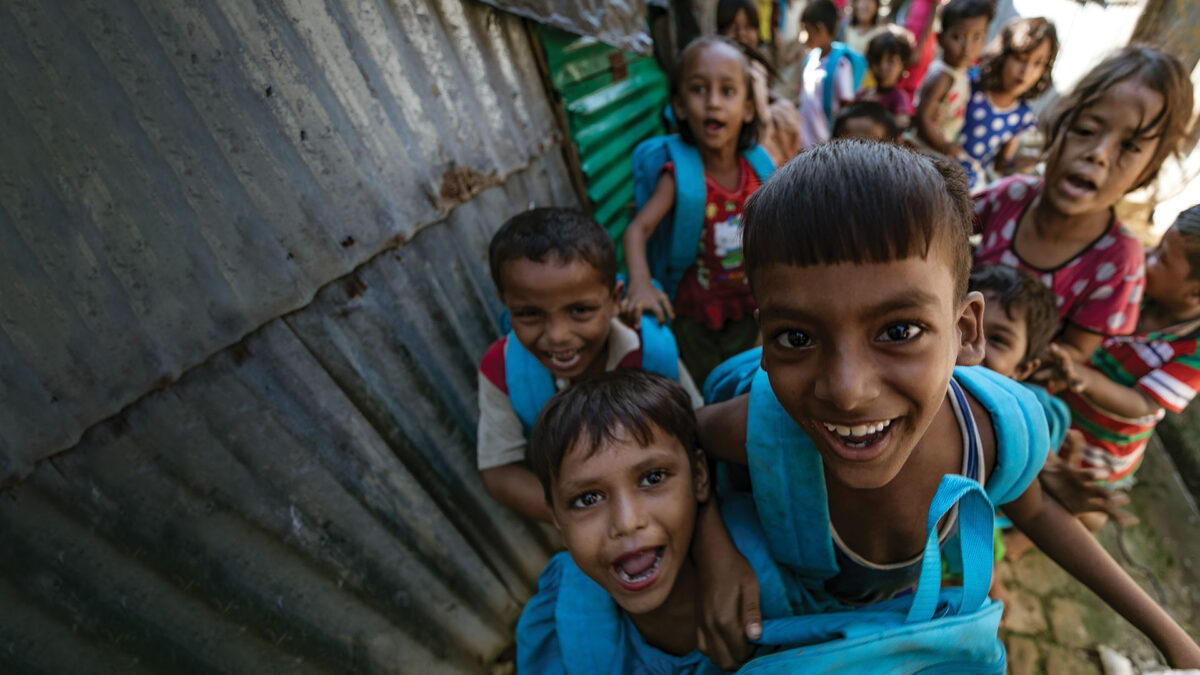The world is learning what the vulnerable have always known: there is no hope without education.

For many of us, these past few months have allowed us to experience what it’s like to have an out-of-school child. Not home for the summer or holidays, but homeschooling, trying to maintain curriculum goals on schedule without proper access to all the things that make school great.
This disruption to normal life— among other side effects of the COVID-19 pandemic—will prove to be a footnote in the narrative of our lives: the time we all tried homeschooling. For some, it reinforces the value of the education system. For others, it was an unexpected distraction filled with blanket forts, virtual learning, and endless sessions of arts and crafts.
If normalcy is here by the time you read this, we will be glad that our children are no longer out of school but simply enjoying a break. Months from now, they will likely return to their educators, resources, playgrounds, and peers, and it will be a bittersweet back-to-school time once again.
EMPATHY BORN IN CRISIS
For 264 million children—the number of kids worldwide who are not attending school—looking forward to classroom time is a cruel daydream. Now that our own children have missed out on their normal educational routines, if only for a few months, we can begin to imagine what it would be like if temporary disruptions to schooling became permanent.
Imagine for a moment that your 8-year-old child has never been to primary (elementary) school. Your child has never participated in a class discussion, has never raised a hand to answer a math problem, has never had a formal opportunity to learn to read and write. For 25 million children in this age group, that scenario is reality. Your hypothetical 8-year-old would be counted among the children who have never seen the inside of a classroom, and—without intervention—likely never will.
Those statistics are even worse if that child is a girl or a refugee or requires special education. According to the United Nations Educational, Scientific, and Cultural Organization (UNESCO), twice as many girls as boys will never start school.¹ In addition, the United Nations High Commissioner for Refugees (UNHCR) states that refugee children are five times more likely to be out of school than their nonrefugee peers.² The United Nations Children’s Fund (UNICEF) reports that 90 percent of children with disabilities in the developing world are not in school.³
This is Rafeef’s world. The 10-year-old Syrian refugee suffers from a debilitating genetic disorder in her spinal cord, and though she may not know these official statistics, she certainly knows how it feels to be out of school. Because her condition affects her vision, mobility, and ability to learn in traditional settings, Rafeef requires special assistance. But in Lebanon, where Rafeef lives, special assistance can be hard to come by.
“Children with special needs require special care,” says Rita Haddad, a project manager for ADRA in Lebanon. “Even girls without special needs are undervalued here in Lebanon. A girl with special needs is given no priority.” ADRA ABILITY is a project tailored to the needs of children with physical and mental challenges such as Rafeef, and is working with her and her family to provide what ADRA believes to be inalienable: equal access to quality education.
Now Rafeef studies one on one with Ahlam, a tutor with the ADRA ABILITY project. Together they work through a curriculum designed to meet her needs. “In Lebanon, if you don’t help girls with special needs, they have no future or hope,” Ahlam says. “A girl with a disability is thought to be incapable of anything. The parents will just try to marry her off to a much older man.”
Early marriage and disability are only two of the many circumstances that keep kids out of school. Other factors include war, poverty, natural disaster, and hunger. In Maputo, Mozambique, chronic malnutrition rates are more than 30 percent, and ADRA has found half of the students in the area to be underweight. To counter this, ADRA partners with Rise Against Hunger, providing hot lunches of rice and soy with dehydrated vegetables fortified with multivitamins. For some students, this school feeding initiative (SFI) provides the only meal they will receive each day.
Just ask Elison. The sixth-grade student would often miss school so he could help his parents, or because he was simply too hungry to walk to school and focus on his studies. Now the 12-year-old can finally sit in a classroom and focus on the lesson, instead of the gnawing hunger in his stomach. “We don’t always have food at home,” he says. “My parents don’t have work, so I don’t bring food to school.”
By providing a nutritious hot lunch each day, ADRA encourages children to recognize school as a place to feed body and mind. As a result, children now attend school in record numbers. “There has been an increase in the number of students,” says Rumbi Muzembi, emergency response coordinator for ADRA in Mozambique. “We started with 9,366, and now we have 13,453 students.”
Those numbers are consistent across southern Africa, where the project has been implemented. Since 2017, ADRA’s school feeding initiative has been improving nutrition and access to education for nearly 50,000 schoolchildren in Mozambique, Eswatini, Madagascar, Zimbabwe, and Malawi.
EVERY CHILD. EVERYWHERE. IN SCHOOL.
Because of the success of ADRA’s many projects to improve the lives of children, and in light of dire statistics that continue to paint a grim picture for children everywhere, ADRA and the Seventh-day Adventist Church have partnered to ensure that every child, everywhere, has a chance to go to school.
The campaign “Every Child. Everywhere. In School.” is a partnership built on a common mutual goal: to serve so all may live as God intended. This partnership unites the global faith community of the Seventh-day Adventist Church with the technical skills and historic success of ADRA.
By mobilizing the faith community, influencing world leaders and decision-makers on education-related policies, and implementing projects that build on successful programs such as ADRA ABILITY and SFI, ADRA and the Adventist Church believe we can ensure every child everywhere has an opportunity to go to school.
Education changes lives. Education elevates children out of conflict, disaster, and poverty. Education equips children with tools for success. And education inspires children to dream big.
With your help, we can extend hope for a bright future to every child, everywhere.
To learn more about how ADRA is supporting out-of-school children and how you can help, visit ADRA.org/InSchool.
² www.unhcr.org/en-us/missing-out-state-of-education-for-the-worlds-refugees.html
³ www.globalpartnership.org/blog/children-disabilities-face-longest-road-education








